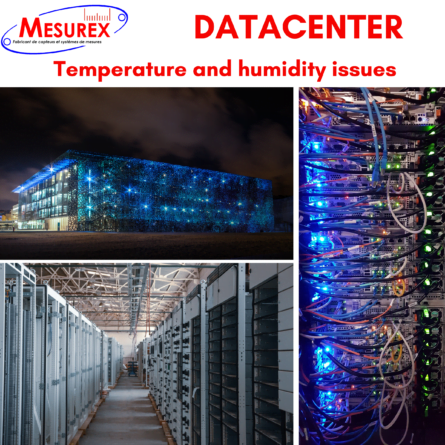Datacenters: tackling security, financial and environmental issues through thermal and humidity control

Internet, Internet of Things (IoT), artificial intelligence, Cloud computing… are boosting the amount of data produced worldwide and consequently the number of datacenters, to manage and store them.
According to market research by “Grand View Research”, the global datacenter market is expected to grow at an annual rate of 11.7% between 2021 and 2028.
In this growing sector, there are many imperatives and challenges:
- Ensure continuity of service
- Implement agile and fast solutions in case of unforeseen events
- Secure facilities
- Embrace the challenges of the environmental impact
- Optimize infrastructure performance
- while ensuring profitability
A datacenter is a microcosm in its own: it must be warm, but not too hot; humid, but not too much; the air must be healthy… The American Society of Heating, Refrigeration and Air-Conditioning Engineers (ASHRAE), that governs the standard for temperature and humidity ranges in datacenter environments, determined in 2011 that a Class A1 datacenter must maintain a temperature between 15°C and 32°C, and a relative humidity of 20 to 80%.
Temperature is obviously the crucial parameter to monitor to anticipate any risk of excessive temperature variation. Overheating can lead to unplanned server downtime, damage or destroy valuable hardware or computer components, or worse, cause a fire. Without reaching that scenario, an outage involves downtime that impacts the financial performance of the installation, and the confidence of customers.
Beyond the security aspect, thermal and hygrometric monitoring of datacenters involves many financial and environmental issues. This sector consumes a lot of electricity. By 2030, the world’s datacenters could use up to 10% of the world’s electricity production (compared to “only” 3% at present) and generate 14% of CO2 emissions by 2040. Solutions to reduce their environmental impact must therefore be integrated to reduce the carbon footprint of datacenters. For example, the simple fact of maintaining a room at 27°C instead of 22°C allows to adjust the ice water regime and make substantial savings. As a reminder, on average, nearly 40% of a datacenter’s total power consumption is allocated to cooling.
Several types of measuring instruments exist to ensure serenity and efficiency of installations. For example:
- Thermo-hygrometers: perfectly suited for this type of monitoring, they measure the temperature coupled with the hygrometry (relative humidity) and are thus able to calculate the dew point temperature. These parameters are extremely important for datacenters, which require a controlled humidity level to avoid electrostatic discharge caused by too dry air. This without falling into excess moisture, which causes oxidation phenomena and therefore premature aging of the components.
- Thermocouple thermometers: to measure the critical temperatures of the hottest components within servers (power supplies, processors, memory and heatsinks). They also monitor the overheating and subcooling temperatures of the refrigerant of Computer Room Air Conditioning (CRAC) units to ensure their proper operation.
- Pressure sensors (manometers): to measure an air flow via Pitot or DEBIMO probes. It is essential to monitor the differential pressure at the air filters, to check the level of fouling and program their change (to reduce downtime). These air filters are also very important to prevent dust accumulation, which catalyzes the formation of electrostatic discharge. Pressure sensors can also be used within hermetically compartmentalized server rooms (between the fresh air inlet area in front of the servers – “cold aisles” – and the hot air evacuation zone – “hot aisles”) to monitor the over-pressure of the cold zone compared to the hot zone, and optimize overall cooling flow.
You want to know more about our products? Visit our website https://mesurex.fr/en/ and let us know your needs mesurex@mesurex.fr
#datacenter #bigdata #datastorage #AI #IoT #Cloudcomputing #riskmanagement #sensor #measurement #temperature #humidity #pressure




